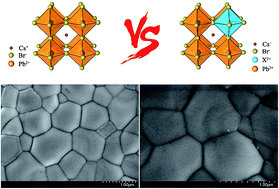Divalent hard Lewis acid doped CsPbBr3 films for 9.63%-efficiency and ultra-stable all-inorganic perovskite solar cells†
Abstract
Substitution of Pb2+ sites with smaller isovalent ions has been regarded as an effective strategy to optimize the crystal lattice of organic–inorganic hybrid perovskites such as releasing lattice strain, increasing the formation energy of vacancies and tuning the bandgap energy distribution. We report here the compositional engineering of the inorganic CsPbBr3 perovskite by doping divalent hard Lewis acids (Mg2+, Ca2+, Sr2+ and Ba2+) and their application in all-inorganic perovskite solar cells free of hole transporting layers and precious metal electrodes. By optimizing the doping dosage, a maximal power conversion efficiency as high as 9.63% is achieved for a CsPb0.97Sr0.03Br3 based photovoltaic device, mainly attributed to the enlarged grain sizes and suppressed formation of point defect (vacancies) within perovskite films, therefore reducing the photocurrent loss within modules. Furthermore, the unencapsulated Sr-containing solar cell shows ultrastability comparable to that of state-of-the-art CsPbBr3 perovskite solar cells under persistent attack in 80% relative humidity over 800 h. The increased efficiency and improved stability demonstrate all-inorganic perovskite solar cells with divalent hard Lewis acid doped CsPbBr3 perovskites to be a new frontier for thin-film photovoltaics.



 Please wait while we load your content...
Please wait while we load your content...